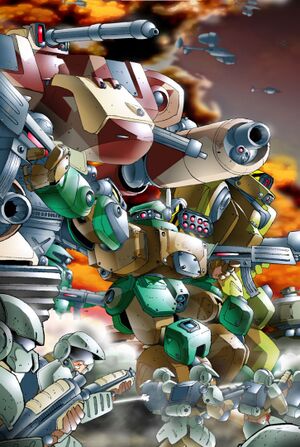The Interpolar War
During the tumultuous period of the early 1930s, the Mekong Dominion had quietly extended overtures to the United Mercantile Federation, suggesting that they might betray the Southern Republic in the event of a Northern invasion. Combined with the battle of Rahnguard Oasis in the Summer of TN1936 and the assassination of Second Follower Thor Hutchison, the North had sufficient impetus to officially declare war on the South. The resulting war was known as the Interpolar War.
Shortly after war was declared, Emir Nigel Shirow of the Free Emirates concluded talks for an alliance with the North as Northern Guard forces advanced into AST lands. Norguard troops reinforced the Free Emirates in their struggle against the loyalist emirate forces, while the Mekong Task Force of the Northern Guard forces advanced into the Dominion territories, expecting to be allowed to enter without a fight. What they did not expect was that the Dominion had never intended to betray the South to begin with, and the Mekong Task Force was harried and torn to pieces over the course of their retreat from the now hostile Mekong Dominion.
Elsewhere, the North made inroads into the eastern territories of the Humanist Alliance, opening up another front in the Southern battlefields along with the conflicts in the nearby Free Emirates region. The South, for its part, launched several offensives against the CNCS, doing significant damage along the Northern border. Yet the polar leagues were not the only combatants in this war. When Dominion Peacekeepers and MILICIA forces caught up with the remnants of the Mekong Task Force near the Badlands cities of Erech and Nineveh, NuCoal, a recently emerging Badland’s power, took exception and dispatched the Port Arthurian Korps (PAK) to drive off the offending polar forces.
Though bloodied, PAK eventually succeeded. In the North, Southern forces counter-attacked at Fort Henry in the Western Frontier Protectorate. Destroying the city-state’s air-defense grid, Southern forces pressed the advantage and continued North, taking the cities of Yele and Skadi, but their advance on the league capital of Sorrento was halted by the Norlight Armed Forces. Undeterred, the Southern forces launched another major offensive through the Karaq Wastes, this time aimed at disrupting the flow of supplies to Northern forces entrenched in the Humanist Alliance and emirate territories. Battle was joined outside the holy city of Massada, and the fighting spilled over into the territory of Peace River, turning the conflict into a three-way melee with elements of the Peace River Army, now known as the Peace River Defense Force, engaging both sides.
By the Summer of TN1938, the people of Terra Nova were through with the cycles of bloody war. Riots and protests shook major cities across the globe. With popular support dwindling and both sides exhausted by two and a half cycles of war, Northern and Southern governments grudgingly agreed to peace talks organized by Peace River. Before the talks could begin, however, an antimatter bomb destroyed Peace River and killed nearly seventy-five percent of its residents. Within hours of the blast, Northern Guard and MILICIA forces stood down from active combat to render any and all aid to survivors of the explosion. The bombing would eventually be tracked back to CEF agents, and the Westphalia Cabinet was formed to manage the impending war against Earth and to continue mediating the peace talks between the poles.
The North pledged to withdraw from the eastern Alliance territories, while the South agreed to return the occupied Northern cities in exchange. In the Eastern Sun Emirates, Patriarch Oliver Masao killed many of his supporters and himself in a bizarre murder-suicide, bringing an end to the Emirate Civil War. With the patriarch dead, a final peace treaty was ratified and the ESE was allowed to rejoin the AST, on its own terms, and the Interpolar War drew to a close.

